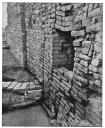The Mystery of the Harappan Disappearance
About
2500 B.C., one of the world's first great civilizations
arose in the Indus River valley, in what is now Pakistan and
western India.
As
with the civilizations in Egypt, China, and the Fertile
Crescent, the Indus River people depended on the river for
their daily needs. They farmed in the rich soil that the
river dumped on its banks. They traded along the river with
other ancient neighbors. These people were unique, though.
They had advanced farther on the civilization scale than any
of their ancient counterparts.
Scholars do not know who the leaders of this first great civilization were, but they do believe that the leaders may have had twin capitals—at Harappa and at Mohenjo-daro, the former on the Indus itself and the latter 400 miles away on the Ravi River, a tributary of the great Indus. Archaeological remains uncovered at these two great city sites suggest that the Harappan civilization, as it is commonly known, was a great one indeed.
 At
each site, a citadel atop a high mound dominates the city
landscape and offers protection for the city proper below.
The people stored grain in large warehouses in preparation
for a famine. They developed a system of weights and
measures to facilitate trade with other cultures, mainly
Mesopotamia. They were the first people in the world to grow
cotton and fashion it into dyed cotton cloth. They dug
ditches and canals to irrigate their farms. They had their
own system of writing that has yet to be deciphered. They
used a common currency.
At
each site, a citadel atop a high mound dominates the city
landscape and offers protection for the city proper below.
The people stored grain in large warehouses in preparation
for a famine. They developed a system of weights and
measures to facilitate trade with other cultures, mainly
Mesopotamia. They were the first people in the world to grow
cotton and fashion it into dyed cotton cloth. They dug
ditches and canals to irrigate their farms. They had their
own system of writing that has yet to be deciphered. They
used a common currency.
Most
striking of all is their civil engineering. They planned the
patterns of their cities, laying out streets in rectangular
patterns and including drainage systems that led to
brick-lined sewers. They lived in brick buildings, some two
and three stories high. In almost every respect, they were
an advanced people. Yet, by 1700 B.C., the Harappan
Civilization had disappeared.